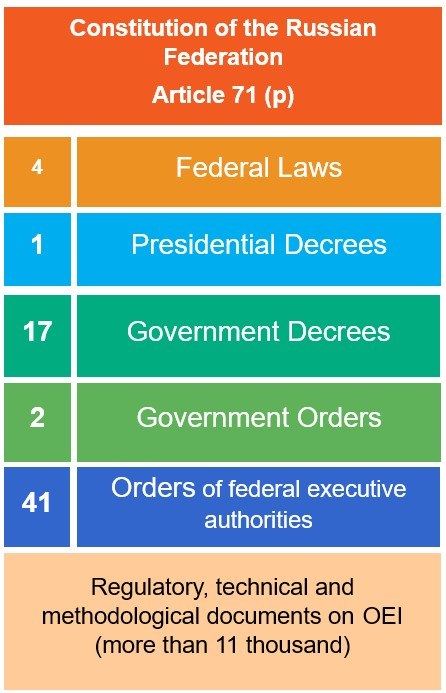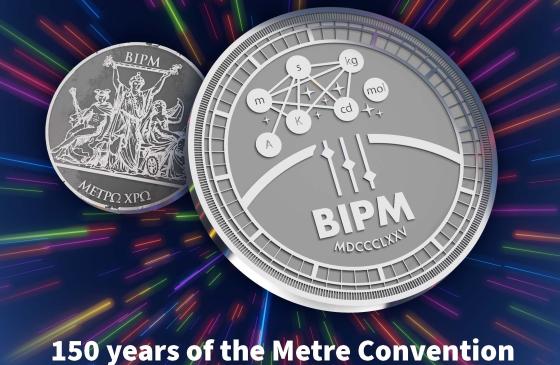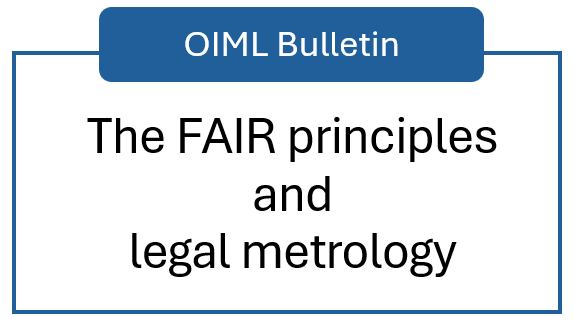OIML BULLETIN - VOLUME LXV - NUMBER 3 - JULY 2024
e v o l u t i o n s
Legal framework of regional and international legal metrology systems in the mutual recognition of measurement results
Sergey Aleksandrovich Denisenko
Lev Konstantinovich Isaev
VNIIMS, Russian Federation
1 Abstract
An overview of the legal framework of metrology at the international level is given, and in particular, the activities of the OIML are described. The establishment of the OIML had an impact on the consolidation of the regulatory framework for metrology at the regional level, especially in the European Union. Reliability, comparability and traceability of measurement results are ensured by international normative documents developed by countries in the field of activities of seven international organizations. For the international recognition of measurements and test results of any country, a system of regulatory documents is needed to ensure that international requirements are fulfilled. Strategically, it is necessary to create a legal framework so that it will be possible to move from regional to global policies. The role of legal metrology at the regional level and the formation of the legislative framework of fundamental metrology in the world are described. A database of basic documents for solving scientific problems in order to ensure the uniformity of measurements at the international level is presented. The main milestones in the history of the formation of the legal framework of the measurement system in Russia are shown. The creation of the state metrological service determined new approaches to improving legislation in the field of metrology. International harmonization of the regional legislative basis documents is the way to resolve problems related to the uniformity of measurements not only in individual countries and regions, but also on a global scale. This should be the starting point for the realization of the motto “Once tested and measured – accepted everywhere”.
Keywords: measurement uniformity, legislative basis, legal metrology, harmonization, traceability of measurement results, public administration
2 Introduction
In different countries, the areas of legal metrology have different specifics. In order to form a basis for regulatory requirements for measurements and measuring instruments in the field of legal metrology, in 1955 the governments agreed to create the International Organization of Legal Metrology (OIML) for socially significant areas - health care, trade, road and industrial safety, and environmental protection.
At the legislative level, the members of the International Committee of Legal Metrology (CIML) undertake to strive to harmonize the requirements for manufactured and operated measuring instruments in these areas in accordance with the requirements of the various OIML International Recommendations.
The creation of the OIML has had a significant impact on the efficiency of the global measurement system, since today the OIML includes 129 states (64 Member States and 65 Corresponding Members), the population of which is about 86 % of the total world population, and the total economy covers about 96 % of the world economy.
The purpose of this study is to describe the legal basis of international metrological practice in Russia, since metrological activities in all countries of the world are under the control of the state and are carried out in accordance with national legislation, and to show that international recognition of measurement and test results requires a system of regulatory documents that ensure international law. Strategically, it is necessary to create an international legal framework so that it is possible to move from a regional policy to a global one.
3 Legal metrology at the regional level
International metrology policy plays an important role in regional legal policy. Against the international background, the process of harmonizing regional regulatory frameworks and legal norms with international instruments is of great importance. The European Economic Community (EEC) is the most illustrative in this regard. Directive 71/316/EEC of the Council of the European Union (“Council of the EU”) of 26.07.1971 on the approximation of the laws of the Member States, concerning common provisions for both measuring instruments and methods of metrological control, was the first common document.
The European Cooperation in Legal Metrology, WELMEC (https://www.welmec.org/), established in 1990 to promote European cooperation in the field of legal metrology and which today unites 38 Members, 11 Observers and 10 Corresponding Members, has done a tremendous amount of work in preparing a draft directive on instruments and systems with measuring functions. The European Parliament and the Council of the EC approved it on 31 March 2004 as the Measuring Instruments Directive (Measuring Instruments Directive, MID) 2004/22/EU.
Measuring instruments that are traceable to standards and that are used for various measuring tasks in the interests of society, public health, safety and order, environmental and consumer protection, taxation and duties, fair trade and which affect the daily life of citizens, should be legally controlled. Naturally, the provisions for legislative metrological control should be identical in all EEC member states, so the European Parliament set a deadline of 2.5 years for the implementation of Directive 2004/22/EU in the legislation of the EEC member states.
Directive 2004/22/EU covers 10 groups of measuring instruments: water meters, gas meters and volume conversion devices, active electricity meters, heat meters, measuring systems for continuous and dynamic measurement of quantities of liquids other than water, automatic weighing devices, taximeters, material measures, sizing systems, and exhaust gas analyzers. Almost all of these groups are included in the scope of OIML, so a lot of work has been carried out to harmonize the requirements of the EU Member States with the requirements of the OIML International Recommendations.
After 10 years, Directive 2004/22/EU was superseded and re-approved by the European Parliament and the Council on 26 February 2014 as Directive 2014/32/ EU. This directive, with a transitional preparatory period of two years, established the need to harmonize the laws of the EU Member States. This includes laws related to the placing of measuring instruments on the market or their commissioning, accreditation of conformity assessment bodies, establishing a framework for the surveillance of products on the market and the control of products from third countries, as well as the establishment of common labelling requirements.
In accordance with the requirements of the Measuring Instruments Directives listed above, all EEC countries wishing to participate in the common market had to harmonize their national legislation in accordance with common requirements. One example of such harmonization is the Measurement and Verification Act of the Federal Republic of Germany (Mess- und Eichgesetz, MessEG1), which entered into force on 1 January 2015. The legal basis of the law is seven European directives, including 2004/22/EU, 2014/32/EU. MessEG, in particular, specifies the main obligations of economic entities (producers, intermediaries, importers, sellers) and the specifics of managing the placement of measuring instruments on the market, as well as the main changes compared to the previous version of the legislation.
In different regions of the world, the tasks of legal metrology are solved both by special organizations (for example, in the Asia-Pacific region the Asia-Pacific Legal Metrology Forum (APLMF) has been established) and by general metrological regional organizations, such as the Intra-African Metrology System (AFRIMETS), the Euro-Asian Cooperation of National Metrology Institutions (Euro-Asian) Cooperation of National Metrological Institutions (COOMET), the Gulf Association for Metrology (GULFMET), and the Inter-American Metrology System (SIM).
4 Formation of the legislative framework for fundamental metrology
Measurement activities in the field of legal metrology should have a solid scientific metrological basis. Today, without reliability, comparability and traceability of measurement results provided by the regulatory framework of fundamental metrology, there can be no trust in measurement results. At the same time, the traceability of measurement results means a confirmed connection between the result of each specific measurement and the standard unit of the corresponding value, provided through an unbroken chain of comparisons, verifications or calibrations, not just calibrations [1]. The basis of such a base is a diplomatic document of 1875 - the Metre Convention, the purpose of which was the international unification and perfection of the metric system by ensuring international unity of measurements, i.e. the need to ensure the uniformity of measurements on a global scale was declared. Theoretical problems were solved by specialists from all countries in international organizations under the leadership of the bodies of the Metre Convention – the International Committee for Weights and Measures (CIPM) and the International Bureau of Weights and Measures (BIPM). As a result of these activities, the following decisions and documents were issued:
- 1960 – The International System of Units, introduced by the decision of the XI General Conference on Weights and Measures (CGPM) and reformed in accordance with Resolution 1 the XXVI CGPM [2];
- 1984 – International Vocabulary of Metrology (VIM) – International Vocabulary of Metrology (JCGM 200:2012), prepared by the Joint Committee on Guidelines in Metrology;
- 1993 – Guide to the expression of Uncertainty in Measurement (GUM) under the auspices of seven international organizations;
- 1999 – CIPM Mutual Recognition Arrangement (CIPM MRA) of the CIPM Mutual Recognition Arrangement2;
- 2006 – Common Statement and Declaration by the BIPM, the OIML and ILAC on the Relevance of various International Agreements on Metrology to Trade, Legislation and Standardization3;
- 2011 – Joint BIPM, OIML, ILAC, and ISO Declaration on Metrological Traceability, updated and reaffirmed in November 2018.
The BIPM, OIML and ILAC Declaration was based on Resolution 6 adopted at the 22nd session of the CGPM, which emphasizes the importance of the mutual recognition of standards, calibrations and tests. Resolution 6 recommended that the CIPM prepare a declaration on the importance and application of the CIPM MRA. At the same time, Member States of the Metre Convention were encouraged to promote the CIPM MRA as a basis for the acceptance of calibration and measurement certificates from national metrology institutes, as well as accredited laboratories that could demonstrate the traceability of national measurements in accordance with the International System of Units. In preparing the recommended declaration, the CIPM recognized that the CIPM MRA should be complemented by similar arrangements developed by the OIML and ILAC. Indeed, all three arrangements are interrelated and support the equivalence and acceptability of measurements tracked by the International System of Units worldwide.
Thus, under the auspices of the bodies of the Metre Convention, a set of basic documents has been established to resolve scientific problems related to ensuring the uniformity of measurements at the international level.
5 Legal basis of the measurement system in Russia
Metrological activity in the Russian Federation today is included in the general system of law. The existing system of measurements in the Russian Federation has specific standards and interacts with the general system of public administration and the state system of generally binding norms within the framework of the economic infrastructure. The Constitution of the Russian Federation establishes the main subjects of competence related to metrology and ensuring the uniformity of measurements – metrological service, standards, standards, the metric system, and the calculation of time. These subjects of competence belong to the federal sphere, which is confirmed by the relevant federal laws [3]. The state has singled out the spheres of the national economy, in which it legislatively assumes responsibility for ensuring the uniformity of measurements and carries out direct regulation in accordance with Articles 1, 21 of the Federal Law “On Assurance of Measurement Uniformity” dated 26.06.2008 No. 102-FZ [Russian Federation Federal Law on Assurance of Measurement Uniformity. Available at: http://coomet.org/DB/isapi/cmt_docs/2022/10/Law_2008_EN.pdf].
Based on the state policy in the field of metrology and ensuring the uniformity of measurements [4], the Strategy for the Development of the System for Ensuring the Uniformity of Measurements was formed and approved by the Government of the Russian Federation. Within the framework of the developed Strategy, the tasks of legal metrology are solved, on the one hand, as a legal basis for ensuring the uniformity of measurements, and on the other hand, as a legal basis for solving problems of public administration through the established system of documents. At the same time, the subject of legal metrology is the establishment, implementation and protection of legal and technical norms regulating relations arising in the course of metrological activities.

The system of regulatory and technical documents in Russia in 2021 is presented in the figure.
The legal basis of the system of measurements in Russia was formed gradually, starting in 1827 with the adoption of the Nominal Decree in 1835 “On the System of Russian Weights and Measures”, which legalized a number of measures of length, volume and weight. In 1842, the Depot of Exemplary Weights and Measures was established under the Ministry of Finance and the Regulations on Weights and Measures of June 4, 1842 were issued. This provided for the creation of local verification branches throughout the territory of the Russian Empire.
After the Revolution of October 1917, the Decree of the Council of the People’s Commissars of the RSFSR of January 25, 1918 introduced the International Metric System of Weights and Measures, which became mandatory on January 1, 1919. This was followed in 1925 by the recognition of the International Metre Convention, concluded in Paris on May 20, 1875, which was in force for the USSR, and on September 25, 1925, the Committee for Standardization under the Council of Labor and Defense (STO) was established, which in 1930 was transformed into the All-Union Committee for Standardization under the STO.
The first practically important and key document for the country’s measurement business in the system of public administration can be considered the Resolution of September 5, 1938 No. 974 “On the Regulation of the Measuring Economy in the USSR” https://www.consultant.ru/cons/cgi/online.cgi?req=doc&base=ESU&n=31647#r5E9btTELrVl9qQm .
This Resolution reads: “In order to improve the measuring economy, the Council of the People’s Commissars of the USSR resolves: 1. To form a Committee for Measures and Measuring Instruments under the Council of the People’s Commissars of the USSR, the main task of which should be to ensure the uniformity, correctness and proper use of scales, weights and other measuring instruments in all branches of the national economy of the USSR.”
The Committee for Measures and Measuring Instruments was entrusted with the centralized management of the verification business of the USSR and the registration of all enterprises manufacturing or repairing measures and measuring instruments subject to verification and stamping. The Committee for Measures and Measuring Instruments under the Council of the People’s Commissars of the USSR was also instructed “together with the People’s Commissariat of Machinery, the People’s Commissariat of Heavy Industry and the People’s Commissariat of the Defense Industry within two months to develop and submit for approval by the Economic Council the arrangements to expand the production of measuring instruments in the USSR in the Third five-year plan, proceeding from the full satisfaction of the entire demand of the national economy for these instruments.”
There was nothing like it in any country in the world. The country’s industry began to switch to new production conditions. Thus, the effective concentration of industry in the Urals and Siberia at the beginning of the Great Patriotic War was prepared.
Post-war reorganizations in the economy led to the creation of the Committee of Standards, Measures and Measuring Instruments under the Council of Ministers of the USSR, the Regulations on which were approved in 1968, and in 1970 this Committee became the State Committee for Standards of the Council of Ministers of the USSR - Gosstandart of the USSR. By that time, the metrological service of the USSR had actually already been formed in the system of management of the national economy of the country, headed by the State Metrological Service (SMS) of the USSR Gosstandart [5]. In accordance with the country’s regulatory documents, the concept of “uniformity of measurements” appeared, which today in accordance with clause 9.1 of the PMG 29-2013 “GSI. Metrology. Basic terms and definitions” means “the state of measurements in which their results are expressed in legal units of quantities or in values according to established measurement scales, and the indicators of measurement accuracy do not exceed the established limits”.
Since the end of the 1960s, ensuring the uniformity and required accuracy of measurements has become the main function of the metrological service of the USSR. By the decree of the country’s leadership of December 9, 1972, the All-Union Research Institute of Metrological Service (VNIIMS) was entrusted with the functions of the Main Center of the State Metrological Service of the country. The metrological service of the USSR, which consisted of the bodies of the State Migration Service, metrological services of state administrative bodies (ministries and departments) and metrological services of enterprises and organizations, became the organizational basis for all activities to ensure the uniformity and required accuracy of measurements in the country. In the State System of Standardization (SSS), a special section 8 “Ensuring the uniformity of measurements” was created.
The areas of ensuring the uniformity of measurements have been regulated at the legislative level since 1983 after the adoption of the Government Decree “On assurance of measurement uniformity in the country”.
Thus, metrological activities received legal support at the level of public administration. The legal basis for effective metrological activity at that time was also strengthened by the Government Decree on State Supervision of Standards and Measuring Instruments (1983) and the Decree of the Presidium of the Supreme Soviet of the USSR “On Administrative Responsibility for Violation of the Rules for Standardization and Quality of Products, Release into Circulation and Maintenance of Measuring Instruments and Their Use” (1984).
After the collapse of the USSR and the transition from administrative methods of economic management to legally regulated methods in the Russian Federation, ensuring the uniformity of measurements received a legal basis in the form of the Law of the Russian Federation of April 27, 1993 No. 4871-1 “On Assurance of Measurement Uniformity” [Law of the Russian Federation on Assurance of Measurement Uniformity. Available at: http://coomet.org/DB/isapi/cmt_docs/2022/10/Law_1993_EN.pdf], as well as Article 71 of the Constitution of the Russian Federation, which entered into force on December 25, 1993, which for the first time established the main subjects of federal jurisdiction related to metrological activities and ensuring the uniformity of measurements.
Metrological activities and measurement practices are important elements of the quality infrastructure, which has a significant impact on the economic infrastructure of the country [6]. That is why there is a need for state regulation of activities to ensure the uniformity of measurements. The creation of a legal framework for this activity provides a legislative basis for the reliability of measurement information for public administration at all levels of activity [7].
6 Conclusion
The global measurement system can work efficiently and sustainably by harmonizing the legal framework of metrological activities between countries at the interregional and interstate levels. Basic documents of fundamental metrology have been adopted, the global quality infrastructure is being formed, and legal issues are being resolved at the regional level. Using this international harmonization, including the OIML Certification System, and based on the experience of the regions and countries, international organizations were able to create a global legal framework for the system of uniformity of measurements in the world. There is a need for a modern international strategy for the creation of a legal system for the global mutual recognition of measurement and test results [8, 9]. A third Working Group within the JCRB could be established to deal with this issue in the interests of legal metrology, so that the principle of “Tested once – accepted everywhere” could be implemented.
7 References
- Isaev L. K., Kuzin A. Yu., Legal aspects of measurement traceability and some national practices in the Russian Federation, OIML Bulletin, April 2023, vol. LXIV, no. 2, pp. 47–53: https://www.oiml.org/en/publications/bulletin/pdf/oiml_bulletin_april_2023.pdf
- Stock M., Davis R., E. de Mirandés, Milton M., Metrologia, 2019, vol. 56, no. 2, 022001. https://doi.org/10.1088/1681-7575/ab0013
- Denisenko S. A., Isaev L. K., Concerning the concept of development of legal metrology in the Russian Federation, Legal and Applied Metrology, 2023, no. 1,
- 5–8. https://www.elibrary.ru/ehkvfp (In Russian)
- Isaev L. K., On the policy of the Government of the Russian Federation in the field of metrology and on assurance of measurement uniformity. Legal and Applied Metrology, 2017, no. 1, pp. 11–14. https://www.elibrary.ru/wfeqoa (In Russian)
- Metrologicheskaya sluzhba SSSR, Moscow, Izdatel’stvo standartov Publ., 1968, 83 p. (In Russian)
- Mason P., The place of Legal Metrology in a National Quality Infrastructure, OIML Bulletin, April 2017, vol. LVIII, no. 2, pp. 25–27. https://www.oiml.org/en/publications/bulletin/pdf/oiml_bulletin_april_2017-1.pdf
- Bogomolov Y. A., Isaev L. K., Kul’ba V. V., Metrology-cybernetics-control: A new approach, Measurement Techniques, 1996, vol. 39, no. 7, pp. 703–707. https://doi.org/10.1007/BF02369920
- Isaev L. K., Mutual recognition of the results of measurements and tests and formation of a world-wide metrology system, Measurement Techniques, 2007, vol. 50, no. 11, pp. 1214–1217. https://doi.org/1007/s11018-007-0227-8
- Brown R., Janssen J.-T., Metrologia, 2021, vol. 58, no. 3, 033001. https://doi.org/1088/1681-7575/abe8e1
1 Mess- und Eichgesetz (MessEG). Gesetz über das Inverkehrbringen und die Bereitstellung von Messgeräten auf dem Markt, ihre Verwendung und Eichung sowie über Fertigpackungen: https://urteile-gesetze.de/gesetze/messeg
2 CIPM Mutual Recognition Arrangement (CIPM MRA): https://www.bipm.org/en/cipm-mra
3 Common Statement and Declaration by BIPM, OIML and ILAC: https://www.oiml.org/en/ about/joint-declarations/pdf/BIPM-OIML-ILAC- Common-Statement--2006-01-23.pdf
<< previous | contents | next >>






